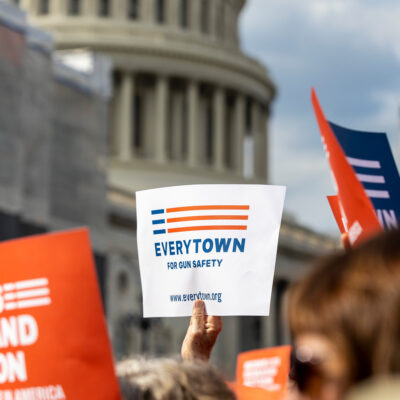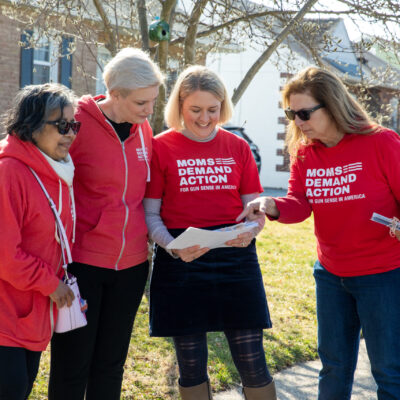Pediatricians, Child and Adolescent Psychiatrists and Children’s Hospitals Declare National Emergency in Children’s Mental Health.
10.22.2021
This week, the American Academy of Pediatrics (AAP), the American Academy of Child and Adolescent Psychiatry (AACAP), and the Children’s Hospital Association (CHA), representing more than 77,000 physician members and 200 children’s hospitals, declared a national state of emergency in child and adolescent mental health, citing soaring rates of depression, anxiety, trauma, loneliness, and suicidality among young people. Although the declaration does not specifically cite lethal means or firearms, research shows that firearm suicide among America’s youth population is nearing an all-time high.
According to the release,
“The COVID-19 pandemic has taken a serious toll on children’s mental health as young people continue to face physical isolation, ongoing uncertainty, fear and grief. Even before the pandemic, mental health challenges facing children were of great concern, and COVID-19 has only exacerbated them.
…
The numbers paint an alarming picture. Between March and October 2020, the percentage of emergency department visits for children with mental health emergencies rose by 24 percent for children ages 5-11 and 31 percent for children ages 12-17.”
Suicide is the second leading cause of death among young people in America. The physical, mental, and environmental stress brought on by the COVID-19 pandemic, in conjunction with the growing threat of gun violence on school grounds, is taking a toll on the mental health of children and adolescents. A 2020 study from the Centers for Disease Control and Prevention (CDC) found that a quarter of young adults (ages 18–24) contemplated suicide during the pandemic. Even as society slowly returns to normal, the ongoing weight of loss, uncertainty and fear can increase feelings of anxiety and loneliness among young people, two factors that elevate the risk of suicide for people of all ages.
The difference between living and dying by suicide is often determined by the presence of a gun. Across all suicide attempts without a gun, 4 percent result in death. But when a gun is involved, that figure skyrockets to 90 percent. Research shows that the vast majority of people who survive a suicide attempt do not go on to die from a later attempt. That second chance matters, and it underscores why addressing gun suicide is an essential element of any strategy to reduce gun violence in this country.
According to a report released by Everytown Support Fund in September, the suicide rate among young people has increased more than 42 percent over the last decade, with increases nearly every year since 2007. This alarming trend has a disproportionate impact on young people of color with young Asian and Pacific Islanders seeing a 71 percent increase and Latinx youth seeing a 63 percent rise during the same period.
Following news of this research, here are resources to help frame ongoing reporting:
- To illuminate the links between firearm access and suicide and highlight approaches to prevention, Everytown for Gun Safety Support Fund released reports detailing the potential impact of coronavirus on gun suicide without action from policymakers and a first of its kind study tracking firearm suicide by congressional district.
- The January 2021 Surgeon General’s report on suicide prevention included recommendations to address gun suicide, such as:
- Storing firearms locked, unloaded, and separate from ammunition.
- Implementing extreme risk laws, which allow loved ones or law enforcement to intervene by petitioning a court for an order to temporarily prevent someone in crisis from accessing guns.
- During periods of crisis, temporarily storing firearms out of the home.
- Partnering with gun dealers and shooting ranges to promote and educate gun buyers on firearms safety and safe storage.
- Improving data collection about suicide deaths.
- Increasing the use of lethal means safety counseling and training health care providers, including nurses, social workers, case managers, and peer workers on lethal means safety counseling.
- Researching lethal means safety strategies and interventions, trusted messengers for suicide prevention, and culturally competent implementation of suicide interventions.
- Effectively implementing the new suicide prevention hotline 988 number.
- Recommendations for Reporting on Suicide, which were developed by suicide prevention experts, international suicide prevention and public health organizations, schools of journalism, media organizations and key journalists as well as Internet safety experts. Their partners include, but are not limited to, American Foundation for Suicide Prevention, Suicide Awareness Voices of Education, American Association of Suicidology, and Suicide Prevention Resource Center.
If our organization can be a resource, do not hesitate to reach out. More information about gun suicide is available here, and the full list of recommendations on how to report on suicide is here.
If you are a survivor of gun suicide and gun violence, resources from the Everytown Survivor Network are available here. If you are struggling and need to talk, the National Suicide Prevention Lifeline is always open: 800-273-8255.




